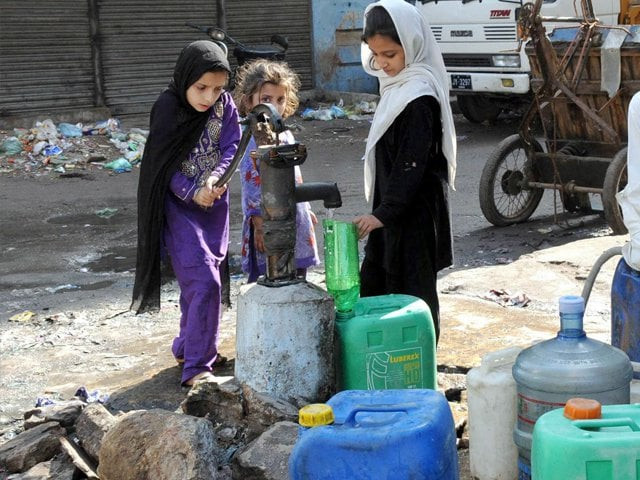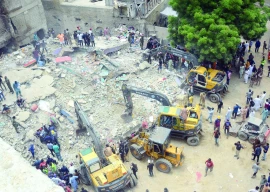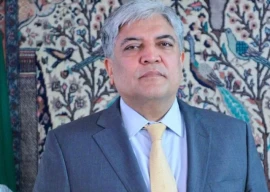
With taps running dry in parts of the capital, a resident from Sector I-10 was compelled to approach the Islamabad High Court last week over this key issue.
Shortfall
Islamabad primarily draws water from the Simly Dam, over 150 tube wells, the Korang water works, the Shahdara waterworks, the Saidpur waterworks, the Noorpur waterworks and Poona Faqiran.
Acute water shortage expected from next week in Sindh
An official of the Islamabad Metropolitan Corporation (IMC) official said that the peak cumulative water production from these sources is around 84 million gallons (mgd) per day for urban centres. Current demand, though, stands at 105 mgd – a nascent shortfall of 21 mgd.
With demand for water ever rising – particularly in the summer, whenever supply dips below 65 mgd, it results in a crisis.
The IMC official said that currently, the water supply directorate was supplying around 56 mgd of water to the city owing to fewer water sources – a greater crisis than normal.

As a result, the official said that residents resort to illegal means to acquire water such as theft by puncturing the main water lines, or other means.
Usually, the shortfall of around 40-50 mgd during the summer season and pre-monsoon months is managed by rationing water supplies. But this year, the shortages seem to have hit much earlier during the winter season, placing the authorities in a fix.
Urban sprawl
The rapid expansion and increase in the capital’s population have been visible over the past decade. But with space within the centre of the capital limited, much of this expansion has been in the suburbs primarily lying to the west and east of the capital.
“The urban sprawl is the highest towards the east and west of the city which is adding to the water woes of civic administrators,” an official in the planning wing of the Capital Development Authority told The Express Tribune, adding that the motorway and new Islamabad airports were the two main factors behind the rapid urbanisation to the west of the capital.
“This area naturally lacks underground water due to its geography. Currently, water shortage in this area is managed somehow by tapping available limited underground water resources,” the official added.
Water shortage: Islamabad Mayor Aziz put on notice
Despite the fact that no comprehensive water supply scheme could be developed for this area, a number of private as well as CDA-backed housing societies are fast being developed in this area.
Similarly, towards the east of the capital in Zone-IV and Zone-V, the situation is comparatively better due to the presence of major water resources such as Simly Dam, Rawal Dam, Soan River, Korang River. Further, the presence of such large water bodies means that the availability of underground water is comparatively better in these zones rather than in Zone- I and Zone-II.
“Zone-IV comprises of an area sprawling over 70,000 acres of land while Zone-V is spread over 40,000 acres of land,” a CDA official said.
Zone-I, the CDA official said, is spread over 16,000 acres of land. Of the 25 sectors in this zone, six sectors including I-14, I-15, I-16 G-13, G-14 and H-12 have been fully developed but lack water supply schemes.
Residents of these areas relying almost entirely on underground sources for water, the situation in Sectors I-10, I-9, G-10 had worsened in winter. But it is unclear whether these water sources have the capacity to fulfil the growing needs of the population in these areas in the future.
Moreover, there is no system in place whereby these water resources can be 'recharged'.
Problems from this manifested late last year and early this year when the low levels of groundwater saw residents of the densely populated Sectors I-9, I-10 and G-10 complain of water shortages during the winter.
Water stressed
Located adjacent to Zone-I and Zone-II of the capital lie the suburbs of Rawalpindi.
Karachi residents suffer as water shortage re-emerges
Here, a large number of housing societies are being built at a rapid pace. Hence housing is expanding over an area of 84,000 acres – which would accommodate over three million people (more than the current population of the capital) once fully developed – in an area where are there few water sources if any.
Per a standard formula of 110 people living on each acre of land, Islamabad's population could rise to 12 million once all four zones are fully developed.
Supply issues hindering development
The water supply situation is such that officials now believe it is among the main obstacles to expanding residential sectors in the capital.
“The scarcity of water, especially that of potable water, remains one of the major issues and obstacles for opening new sectors in Islamabad,” an official at Islamabad Metropolitan Corporation’s (IMC) water directorate told The Express Tribune.
The issue of water in the capital, though, seems to be cyclical.
While the city’s administration has been struggling to meet existing demand for water, at the same time the population of the capital has been increasing at a rate of over five per cent per year to 1.75 million today – hence increasing the demand for water every year.
This increased population and thus demand adds to the water supply burden of the capital and hence adding to delays in opening new residential sectors to house the grown population.
“Water sources in the capital city have not been developed since 1980, except for the Kanpur Dam which was developed in 2004 and only partly shares the burden of water supply to the urban areas of Islamabad,” the official said.
Solution
To cater the growing shortfall in supplying potable water to an ever-expanding population, the federal cabinet had as far back as 2004 had decided to implement a long-term strategy whereby future water requirements would be met by developing additional water sources.
The focus was thus set on two major water sources – the Indus River from Tarbela Dam and the Jhelum River from Mangla Dam.
The CDA tasked MM Pakistan and Mott McDonald (UK) in 2005 to devise case studies.
“Tarbela lake was found to be the optimal choice to meet the current demand of 200 mgd in addition to meeting any future requirements of the twin cities,” CDA Spokesman Mazhar Hussain said.
“The Council of Common Interests in June 2011 approved water allocation of 400 cusecs for phase-I,” he said, adding that the study suggested that around $1.2 billion would be required for implementing the project.”
Published in The Express Tribune, May 6th, 2017.
1724919650-0/Untitled-design-(5)1724919650-0-270x192.webp)

















COMMENTS
Comments are moderated and generally will be posted if they are on-topic and not abusive.
For more information, please see our Comments FAQ